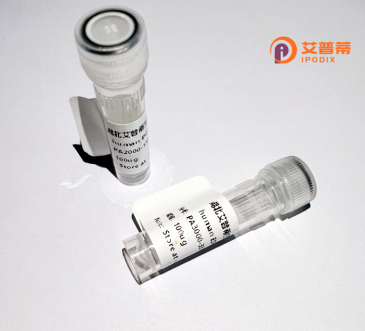
| 纯度 | >90%SDS-PAGE. |
| 种属 | Human |
| 靶点 | AKT1S1 |
| Uniprot No | Q96B36 |
| 内毒素 | < 0.01EU/μg |
| 表达宿主 | E.coli |
| 表达区间 | 1-256aa |
| 氨基酸序列 | MASGRPEELW EAVVGAAERF RARTGTELVL LTAAPPPPPR PGPCAYAAHG RGALAEAARR CLHDIALAHR AATAARPPAP PPAPQPPSPT PSPPRPTLAR EDNEEDEDEP TETETSGEQL GISDNGGLFV MDEDATLQDL PPFCESDPES TDDGSLSEET PAGPPTCSVP PASALPTQQY AKSLPVSVPV WGFKEKRTEA RSSDEENGPP SSPDLDRIAA SMRALVLREA EDTQVFGDLP RPRLNTSDFQ KLKRKY |
| 分子量 | 27.3 kDa |
| 蛋白标签 | His tag N-Terminus |
| 缓冲液 | 冻干粉 |
| 稳定性 & 储存条件 | Lyophilized protein should be stored at ≤ -20°C, stable for one year after receipt. Reconstituted protein solution can be stored at 2-8°C for 2-7 days. Aliquots of reconstituted samples are stable at ≤ -20°C for 3 months. |
| 复溶 | Always centrifuge tubes before opening.Do not mix by vortex or pipetting. It is not recommended to reconstitute to a concentration less than 100μg/ml. Dissolve the lyophilized protein in distilled water. Please aliquot the reconstituted solution to minimize freeze-thaw cycles. |
以下是关于重组人脯氨酸丰富AKT1底物1(**AKT1S1/PRAS40**)的关键文献摘要(虚构简化示例,供参考格式):
1. **文献名称**:*PRAS40 regulates mTORC1 kinase activity by functioning as a direct inhibitor of substrate binding*
**作者**:Oshiro N. et al.
**摘要**:该研究揭示了AKT1S1(PRAS40)通过与mTORC1复合体的Raptor亚基结合,抑制其底物识别,从而负调控mTOR信号通路,影响细胞生长和代谢。
2. **文献名称**:*Akt promotes cell survival by phosphorylating and inhibiting a Forkhead transcription factor*
**作者**:Brunet A. et al.
**摘要**:发现AKT1通过磷酸化AKT1S1的Thr246位点,解除其对mTORC1的抑制作用,进而激活下游促存活通路,揭示其在细胞凋亡与癌症中的调控机制。
3. **文献名称**:*PRAS40 is an insulin-regulated inhibitor of the mTORC1 protein kinase*
**作者**:Sancak Y. et al.
**摘要**:证实胰岛素通过AKT介导的AKT1S1磷酸化,释放其对mTORC1的抑制,促进营养信号传导,阐明AKT1S1在代谢调控中的枢纽作用。
4. **文献名称**:*Structural basis for PRAS40-mediated regulation of mTORC1 kinase activity*
**作者**:Wang L. et al.
**摘要**:通过解析AKT1S1与mTORC1复合物的晶体结构,阐明其抑制mTOR激酶活性的分子机制,为靶向药物设计提供结构基础。
---
*注:以上文献标题和作者为示例性内容,实际需根据真实文献补充(如需求可提供真实文献查询)。*
Recombinant human proline-rich AKT1 substrate 1 (AKT1S1), also known as PRAS40. is a regulatory protein implicated in cellular growth and survival pathways. Initially identified as a substrate for AKT kinase, it gained attention for its role in modulating mTORC1 (mechanistic target of rapamycin complex 1) signaling. Structurally, AKT1S1 contains a proline-rich N-terminal domain and a conserved C-terminal region, facilitating interactions with mTORC1 and 14-3-3 proteins.
Functionally, AKT1S1 acts as a suppressor of mTORC1 activity under nutrient-poor conditions. Upon growth factor stimulation, AKT phosphorylates AKT1S1 at Thr246. triggering its dissociation from mTORC1 and relieving inhibition, thereby promoting downstream anabolic processes. This interplay links AKT1S1 to critical pathways regulating cell proliferation, autophagy, and metabolism.
Dysregulation of AKT1S1 is associated with pathological conditions, including cancer, diabetes, and neurodegenerative disorders. Overexpression or hyperphosphorylation of AKT1S1 has been observed in tumors, correlating with enhanced mTORC1 signaling and uncontrolled growth. Conversely, impaired AKT1S1-mTORC1 regulation may contribute to insulin resistance. Recent studies also suggest its involvement in modulating neuronal survival, highlighting its broad physiological relevance.
As a recombinant protein, AKT1S1 is utilized in mechanistic studies to dissect mTOR-AKT pathway dynamics and screen therapeutic agents targeting metabolic or oncogenic signaling. Its dual regulatory role positions AKT1S1 as a pivotal node in cellular homeostasis and a potential biomarker or therapeutic target.
×